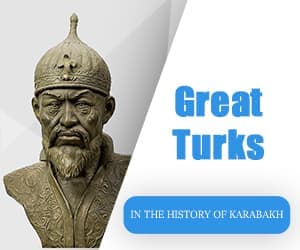Qarabag.com has prepared a historical survey material about the ethnic cleansing of Azerbaijanis in Zangezur from late 1917 to 1991. 7 sources were utilized in the preparation of the material.
December 1917 – August 1918: In the first section of Zangezur district 15 villages were demolished by Armenians, 625 people were killed.
[Historical Geography of Western Azerbaijan. Publishing house of St.Petersburg University, 2007. P. 73-74]
The Armenian army under the command of Andranik invaded Zangezur. Until the end of October 115 settlements were destroyed, 7700 Muslims were killed, 2500 were wounded, 50.000 people were expelled from their homes.
[Hasanly J. History of Diplomacy of the Republic of Azerbaijan: in 3 vol. Vol. II: Foreign policy of Azerbaijan in the years of Soviet power (1920-1939). Moscow, 2013. Page. 172]
26.11.1918: Armenians demolished Muslim villages in Meghri: Leghvaz, Tey, Mulk, Vartanazor 1, and Vartanazor 2, 200 civilians massacred.
[Historical Geography of Western Azerbaijan. Published by the St. Petersburg University, 2007. Page 255]
December 1918: Dashnaks destroyed more than 100 villages of the Kafan district of Zangezur district. More than 40 thousand locals were expelled from these villages
[Historical Geography of Western Azerbaijan. Published by the St.-Petersburg University, 2007. Page 218]
20.12.1918: At 4 session of ADR parliament presiding H.B.Agayev dubbed the text of first enquiry: “Recently according to the information received, Andranik, together with the group under his command, crossing the border of the Republic of Azerbaijan, is committing atrocities in Shusha, Zangezur and Jevanshir districts, ruining many villages, plundering the population and subjecting them to disasters and all kinds of deprivations…”
Foreign Minister of ADR F. Khoyski stated at the meeting: “…Andranik, taking advantage of the fact that the government of the Republic of Azerbaijan was engaged in the Baku operation, continued to commit atrocities in Zangezur, trying to cleanse the area from the Muslim element, and for this purpose he laid defenseless Muslim villages located there to waste with fire and sword“. He also stated that Andranik planned to “cleanse” Zangezur and Shusha of the Muslim population and tear these pieces from the living body of Azerbaijan.
[Republic (1918-1920). Parliament (Verbatim records). Baku, 1998. Pages. 36-37]
January 1919: Up to 40,000 Muslims from the Zangezur district fled to the borders of Jebrail, Shusha, and Javanshir counties of Karabakh and other places in the republic.
… “All Muslim villages of the 1st police district of Sisian region, most of the villages of the 2nd district, most of the villages of the 3rd, 4th, and 5th districts have been destroyed. Many villages were completely destroyed by the Armenians and 50,000 Muslim refugees found shelter in the Jebrail district”. In Zangezur district 115 Muslim villages were destroyed. 3,257 men, 2,276 women, 2,196 children were killed. 1060 men, 794 women, 425 children were wounded. In all districts, 10068 persons of the Muslim population were killed and crippled.
[The historical geography of Western Azerbaijan. Publishing house of the St.-Petersburg University, 2007. P. 77-78]
29.01.1919: Zangezur district governor G. Mahmudbekov informed Kh. Hasmamedov in a telegram that Muslims of Akhchin gorge of Zangezur district are on the eve of extermination. Villages Kushchilu, Adjilu, Arkazu, Aksarlu were crushed by Armenians at the beginning of January, villages Shagardzhikh, Achaguv, Ohchi surrendered to Armenians after a siege, and villages Kiratag, Molodu, Kovna, Karabagly, Gavarli, Kichi, Bashbaki, Mahmudlu, Keidashi, Kachag, Kurugot, Kayhan, Kiri, Abjibaji were besieged by Armenians demanding they surrender their weapons, threatening to exterminate them otherwise.
[The Democratic Republic of Azerbaijan (1918-1920). Army (Documents and materials). Baku, 1998. Page. 196]
10.04.1919: Armenians of Zeyva village suddenly attacked Muslims of Tarovlu village of Zangezur district. This attack was a signal to start hostile actions against Muslims all over the district. Starting from the village of Alikuluushagy up to the limits of the 4th section of Zangezur district an exchange of fire between the two nations has started, where a partial advance of Armenians is observed. The Muslims are holding to a defensive tactic, but due to the lack of sufficient ammunition and rifles, the situation of the Muslims is extremely difficult.
[The Democratic Republic of Azerbaijan (1918-1920). The Army (Documents and materials). Baku, 1998. Page 203]
October-November 1919: The Armenian government continued to send its regular troops, weapons, and all kinds of military equipment to Zangezur to distribute among the Armenian population. The number of Muslim refugees in Zangezur was about 60,000.
[The Democratic Republic of Azerbaijan (1918-1920). Foreign policy (Documents and materials). Baku, 1998. Page. 375]
07.11.1919: Levestam’s group, assisted by 6 mountain guns and 2 howitzers, launched an attack on Dyg. They succeeded in repelling the attack and kept Levestam from occupying the village of Dyg.
[The Democratic Republic of Azerbaijan (1918-1920). Army (Documents and materials). Baku, 1998. Page 240]
17.11.1919: In the message of the deputy allied high commissioner in Transcaucasia K.J.Rey, the chairman of the Council of Ministers N.Y. Usubbekov is quoted about the intentions of Azerbaijani authorities to stop further devastation of Muslim villages by Armenian rioters in Zangezur, return 60 thousand destitute Muslim refugees to their homes and restore order.
[The Democratic Republic of Azerbaijan (1918-1920). Foreign policy (Documents and materials). Baku, 1998. Page. 370]
23.11.1919-17.01.1920: About 40 Muslim villages were destroyed by Armenians in the Zangezur district.
[The Democratic Republic of Azerbaijan (1918-1920). Foreign policy (Documents and materials). Baku, 1998. Page. 436]
By 29.11.1919: The Armenian army destroyed the villages of Ochunir, Davidan, Atkiz, Shabadan, Anishu, and Kushnilar in the Zangezur district. The village of Kilatagh and all surrounding Muslim villages were deprived of any communication and surrounded by Armenians.
[The Democratic Republic of Azerbaijan (1918-1920). Foreign policy (Documents and materials). Baku, 1998. Page. 383]
09.12.1919: Armenian military operations continue in Zangezur, the Muslim civilian population is massacred and many villages are burnt down. The Muslim villages of the Okhchin and Kgin gorges are finally crushed by the artillery of Armenian regular units. The majority of the Muslim population is slaughtered. The villages of Kechiklu, Askerlu, and Pirchevan in the Zangelan district were crushed. The rest of the Muslim population, under the pressure of these events, fled their villages. Armenian military units with artillery and machine guns are actively exterminating the Muslim population and destroy their property.
[The Democratic Republic of Azerbaijan (1918-1920). Foreign policy (Documents and materials). Baku, 1998. Page. 388]
30.12.1919: In a letter to the Allied High Commissioner in the Caucasus, Colonel V.N. Gaskel, deputy diplomatic representative of the ADR in Georgia, F. Vekilov reports the violation of the terms of the agreement signed by the Armenian side on 23 November 1919 in Tbilisi. He also noted that attacks on Muslims in Zangezur have a devastating effect in Azerbaijan, making the idea of peaceful resolution of disputed issues unpopular.
[Azerbaijan Democratic Republic (1918-1920). Foreign policy (Documents and materials). Baku, 1998. Page. 419]
19.01.1920-22.01.1920: Armenian troops joined by armed gangs started an attack from Zangezur in the direction of Shusha district, on the way they exterminated Muslim villages, 9 of which were destroyed.
[The Democratic Republic of Azerbaijan (1918-1920). Parliament (Verbatim records). Baku, 1998. Page 243]
08.03.1920: The telegram of M.N. Vekilov of MIA of Azerbaijan Democratic Republic informs that 7 thousand Armenian troops went from Dilijan through mountains to Zangezur.
[The Democratic Republic of Azerbaijan (1918-1920). Army (Documents and materials). Baku, 1998. Page 250]
09.03.1920: At an emergency session of the ADR Parliament, Musavat Party member Shafi-Bek Rustambekov stated that in the Erivan and Zangezur districts the Armenian government had started to destroy Muslim villages and subjected their population to extermination and violence.
[The Democratic Republic of Azerbaijan (1918-1920). Parliament (Verbatim records). Baku, 1998. Page. 493]
At the same meeting, M.E. Rasulzade spoke: “The Armenian government is used to manipulating European public opinion in its favor; when some Keibalikand accidentally suffers a misfortune, there is an incredible uproar and a friendly cry from the entire Armenian nation around it. This cry is transmitted around the world, seeking the support of Europe. And when whole regions are brutally annihilated and Muslims are mercilessly massacred by the Armenian regular army, up to 40 villages destroyed, all their property laid waste by fire and sword, women, children and the elderly killed by the thousands, no one knows and does not want to know about it, and the Armenian government calls these horrors “expulsion of alien elements and provocateurs”. No, this is not “capture of provocateurs”, but the organized extermination of Muslims of the area in question. Attempts to create an artificial majority of the Armenian population there to put Europe before the fait accompli.
[The Democratic Republic of Azerbaijan (1918-1920). Parliament (Verbatim records). Baku, 1998. Page. 497]
22-23.03.1920: Armenian armed forces attacked Muslim villages within the Jebrail and Zangezur counties. Some of these villages were destroyed.
[The Democratic Republic of Azerbaijan (1918-1920). Foreign policy (Documents and materials). Baku, 1998. Page. 489]
23.03.1920: Several Armenians came from Herenzur to burn the village of Malkhalaf in the Zangezur district, but the attack was repelled.
[The Democratic Republic of Azerbaijan (1918-1920). Army (Documents and materials). Baku, 1998. Page 272]
July 1920: On the eve of the occupation of the territory of Zangezur by the troops of the Xl Red Army, the population of the district was ethnically mixed. As a result of Armenian aggression, the Muslim villages of Zangezur were destroyed, burnt down and the remaining Muslim population found shelter in the Muslim eastern part of Zangezur, mainly in the Gubadli district.
[Niftaliyev I. Azerbaijani SSR in the expansionist plans of Armenians (the 20s of the twentieth century). Baku, 2010. Pp. 69-70]
1918-1920: Azerbaijanis, who had lived in Eastern Armenia for many centuries, were discriminated against and pushed to the social margins. Tens of thousands of Azerbaijanis were expelled from Zangezur.
[Thomas de Waal. Black Garden. Armenia and Azerbaijan Between Peace and War. Page 120]
The 1940s: Tens of thousands of Azerbaijanis deported from Zangezur and Eastern Armenia to Azerbaijan to make place for Armenian returnees.
[Thomas de Waal. Black Garden. Armenia and Azerbaijan Between Peace and War. Page 120]
1948-1953: 150,000 people were forcibly relocated from the Armenian SSR to the Azerbaijani SSR.
[Historical Geography of Western Azerbaijan. Published by the St.-Petersburg University, 2007. Pages 83-84]
November 1987: Two freight wagons with Azerbaijanis who had been forced to flee Kafan due to inter-ethnic clashes arrived at the Baku railway station.
[Thomas de Waal. Black Garden. Armenia and Azerbaijan Between Peace and War. Page 40]
25.01.1988: Arif Yunusov, a resident of Baku, saw four red “Ikarus”buses with refugees from Kafan.
“They were all in a terrible state. Mostly there were women, children, and old people. There were a few young people. Many were badly beaten. They were screaming…” – Yunusov recalls.
[Thomas de Waal. Black Garden. Armenia and Azerbaijan Between Peace and War. Page 40]
February 1988: Second Secretary of the Kafan Party Committee Aramais Babayan confirms that 2,000 Azerbaijanis have fled the Kafan district.
[Thomas de Waal. Black Garden. Armenia and Azerbaijan Between Peace and War. Page 41]
1988: The population of 37 Kafan villages was expelled within a week, including 280 of 300 families from the Sheherjik village in the Kafan district, who are living now in Baku and Sumgait.
[Historical Geography of Western Azerbaijan. St. Petersburg University Press, 2007. Pp. 86, 219-220]
08.08.1991: Residents of the last Azerbaijani village of Nuvadi in the Syunik region of Armenia (formerly Zangezur district) fled their homes.
[Historical Geography of Western Azerbaijan. St. Petersburg University Press, 2007. Pages. 33-34]




